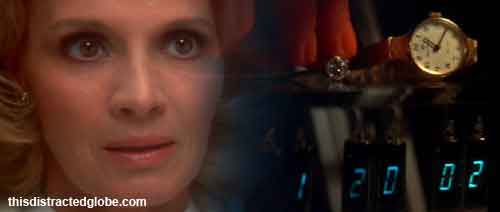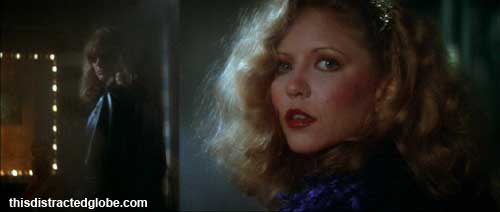
|
|
Dressed To Kill1980. Cinema 77 Films. Directed By Brian De Palma. Written By Brian De Palma. With Michael Caine, Angie Dickinson, Nancy Allen. 
A wife frustrated about her sex life finds affection from a man she has played chase in an art gallery one day. They make love in the cab and in his apartment until she wakes up alone, dresses up, writes a note to the stranger with whom she has just had a wonderful afternoon, and discovers the man has a venereal disease. She hurries to the elevator until she remembers she has left her ring. She is about to go back to his apartment when the elevator door opens and she finds herself face to face with a blonde woman in dark glasses and leather coat. The blonde slashes her throat to death with a razor. The sole witness who has seen the face of the killer is a young prostituted woman, Liz, and now Liz is both suspected by the detective as the killer, and is chased by the real killer. Liz teams up with the victim's teenage son to find out who the real killer is. The major characters in the story can be classified the way we see in conventional crime thrillers: the law breaker, the victim and/or the witness, and the law enforcer. In crime thrillers, there could be variations in the plot as to where the focus of the narration would be, and who will be the protagonist of the story. In this particular film, a prostituted woman becomes the protagonist for an unexpected turn of event. She chances upon seeing in the elevator a woman dying from getting slashed. She sees the killer, a woman in dark shades and leather coat. She becomes a suspect, with no one else to prove her innocence but the man she is with that night who has run away from the crime scene. Next thing she knows, she is the killer's next target. She realizes that she just cannot let the case be. She must solve the case - first, to clear her name; second, to help the woman's son, and third, to save her life as well. 
A horror film does not always require a supernatural phenomenon or a monster that is nonexistent in real life. The monster is not necessarily ugly and disgusting. In Dressed To Kill, it is obvious that the real killer is what we shall call the "monster." What makes the blonde woman in dark shades and black leather coat a monster is that: (1) we do not know who she is and where she comes from; (2) we barely see her face because of her dark glasses; (3) we do not know why she has killed Kate, and why now she is trying to kill Liz; (4) this woman is capable of killing just like that, with a razor in her hand; and (5) we discover that she is not a woman, but is actually Dr. Elliot, Kate's psychiatrist in disguise, who turns out to be a transvestite and is suffering a split personality disorder. Particularly in this film, like a number of contemporary horror films, the "monster" is attractive, with a good profession, looks decent, but with a dark secret which he may or may not be aware of. We are given some clues about that secret, but only very little. This is why we are oftentimes misled as to who the killer is. Aside from the fact that we do not know who the killer is, because the identity is unknown to us yet, part of the suspense, and the horror of it, comes from the fact that we do not know when he or she will attack, because then the killer may just be around any of the main characters and may just slash their throats at any given time. The film is also an erotic horror. Sex is one recurrent theme in the plot. The victim in the story has a frustrating sex life with her husband. She represses her feelings and seeks the advice of her psychiatrist. The film opens with Kate's sexual fantasy, which turns into a nightmare. There is also the possibility that her sexual-fantasy-turning-into-a-nightmare is just a sexual fantasy in its continuity. There are a lot of Freudian themes in the film such as the women's (Kate's and Liz's) sexual fantasies and erotic/ sadomasochistic dreams, and of course the beautiful chase in the art gallery where it would seem that Kate enjoys chasing and being chased, and the shower scene at the end, which again we do not know if it's a nightmare or another sexual fantasy only buried somewhere deep down Liz's subconscious. Considering all these, the distinction between fear and desire, and fright and pleasure blurs, as it both bring a certain excitement to the women in the film, and to some extent, even to the viewers. Kate's sensuality awakens, until she becomes attracted to the "unknown" - a man she does not even know whom she meets that afternoon in the art gallery. We, on the other hand, in the course of the film learn to anticipate that after an erotic scene, a shower scene, or a stripping scene is another adrenalin-producing cat-and-mouse chase between the killer and the target. As a horror film, Dressed To Kill is disturbing both to social and moral conventions. It challenges the concept of sexual liberation especially among women and homosexual. There is a sense of sexual liberation in characters, but they would later find out that this liberation is also bound at the same time. Kate, who goes in search of her sexual satisfaction, shakes the foundation of her morality, and gets the "horror" of it - when she feels guilty hearing the voice of her husband on the phone, she discovers about that the man she has just slept with has a disease, and finally, she gets killed. Dr. Elliott, on the other hand, is a decent man who "[loves] his wife," therefore he won't sleep with Kate. But inside him is another personality who longs to be a woman. |
| © 2009 Kris Rajani Nagera | |||||||